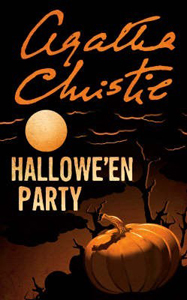Agatha Christie is capable of writing spooky stuff, but it’s not till Poirot’s third-to-last novel, “Hallowe’en Party” (1969), that we get a Halloween-set yarn. Similar to “Hercule Poirot’s Christmas” (1938), it’s not a bad book, but it doesn’t lean into a holiday vibe like I hoped for.
Seasonal spice
The party features bobbing for apples and playful fake spiritualism. Witches are mentioned. And of course there’s a murder. But this isn’t a scary story like we know Christie can write. “The Sittaford Mystery,” “Appointment with Death” and “Death Comes as the End” are a few that have that vibe.

“Hallowe’en Party” (1969)
Author: Agatha Christie
Genre: Mystery
Series: Hercule Poirot No. 41, Ariadne Oliver No. 7
Setting: Woodleigh Common, U.K., 1969
Instead, “Hallowe’en Party” stands out by giving insight into Christie’s views of youth culture and rising crime in the 1960s. The victim is a teenager, something that bothers some readers who believe the author is being too cruel or crass.
But there’s a point to it: She’s illustrating her belief – as reflected through Poirot and others – that we’re living in a less safe, less predictable world.
Slow moving
That’s not to say she sympathizes with youths. Joyce is widely known as a liar — and indeed, her possible lie about seeing a past murder might’ve signed her death warrant. Through Poirot’s interviewees, Christie brings up this trait about Joyce so many times that “Hallowe’en Party” almost spins its wheels.
There’s a point to that particular repetition, but the story is slower moving than elite Christie works. The momentum picks up at the point of Poirot solving it and revealing his solution. Here, “Hallowe’en Party” adds Shakespearean, Greek and Biblical mythology. (I also love the explanation behind a suspicious but utterly bizarre event at the Halloween party.)
There’s no good reason why Christie couldn’t have peppered the literary material into the book earlier. It’s almost like she wrote a draft but didn’t take another pass to make it richer.
Young and old
I find the adult characters too thinly drawn. Christie herself seems to realize that, as she conveniently adds two old favorites to this small town’s dramatis personae: retired inspector Spence (“Mrs. McGinty’s Dead”) and author Mrs. Oliver (six previous tales). But here, they are little more than Poirot’s sounding boards.
Surprisingly, Christie’s strength here is writing the children. They are broadly drawn (Joyce is a liar, another kid wants money to buy things, two others feign maturity but are only humoring Poirot). But that’s appropriate for youths – whom we often see in one-dimensional terms, fairly or not.

The large cast of youths serves as a contrast to Poirot, whose elderly status is mentioned multiple times. He moves slowly, although this is ostensibly because of his poor choice of shoes. He’s not too old for this – his little grey cells still fire off each other – but “Hallowe’en Party” has an overall sense of tiredness.
Christie might’ve carved this jack-o-lantern of a novel into something great earlier in her career. Now she’s content with it being good.
Every week, Sleuthing Sunday reviews an Agatha Christie book or adaptation. Click here to visit our Agatha Christie Zone.

